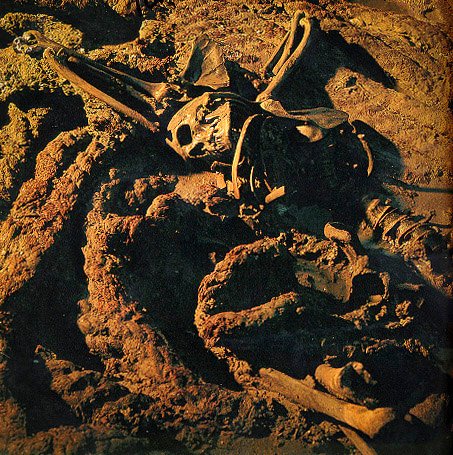
It was just past midnight when I bolted upright in bed because of the sounds coming from the heavy rain, wind, and waves slamming against the wall of the metal office building where I was sleeping. I was a little disoriented at first and it took a couple of minutes to make sense of my surroundings. I was the assistant director on a project using a cofferdam to create a hole to the seafloor so a team of archaeologists could excavate a 17th-century shipwreck, and tonight it was my turn to stand guard. The cofferdam was built to isolate the site from the surrounding water and then using pumps, remove the water from the inside so the team could excavate in the open air instead of underwater. Due to the significance of this particular shipwreck and because it was 15 miles offshore, one member of the crew had to stay each night to keep an eye on things. On this night, it was my turn.
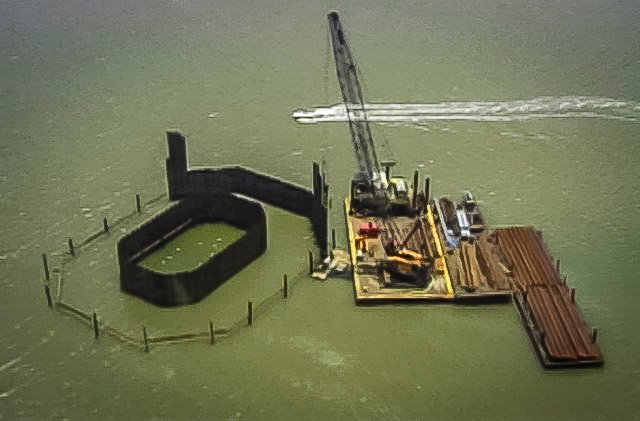
As the day's activities came to a close, the team was all abuzz since we had just uncovered the entire skeleton found amongst the shipwreck remains. We spent most of the day drawing, photographing, and cataloging the skeleton but now it was time to leave because a storm was brewing. We had seen several others come and go, so we didn't think too much of it. We knew water would leak into the cofferdam, as it always did, but we had water pumps running 24/7, so we felt sure it would all be OK. The team put everything away for the night, boarded the research boat, and headed back to shore leaving me behind to weather the storm and make sure everything was safe. I went about the task of checking our equipment to make sure it was all put away or tied down. We didn't want to lose anything. Around 8 pm, I finished my rounds and headed to the office where I could make dinner and eventually go to sleep. Finally, around 10 pm, I climbed into bed.
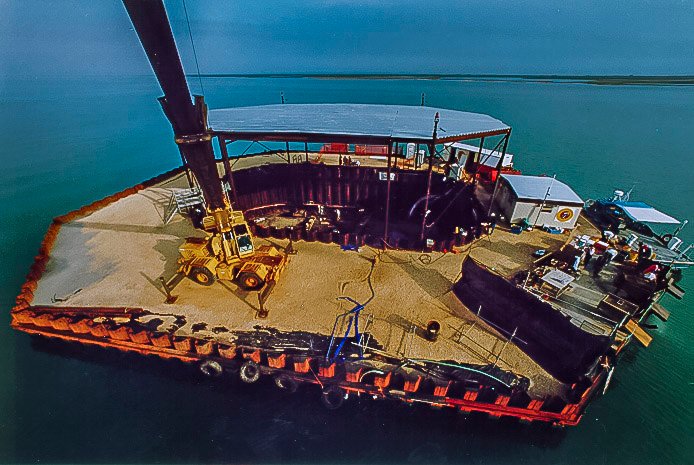
As I slept, a strong cold front blew in, creating torrential rains and big waves. As I mentioned, storms were normal occurrences during the fall and winter months, and the cofferdam was more than capable of withstanding just about any type of storm. But this storm was different.
After I collected myself, I went to the window and looked out on the deck, but all I could see was darkness. Normally, we had a floodlight that ran each night, but for some reason, it was off and I couldn't see anything. I could hear the wind and the waves breaking over the bow of the barge, however, and it was loud.
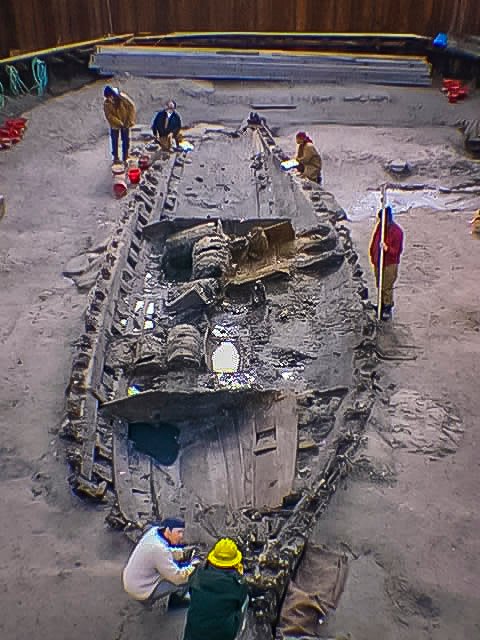
More than anything, it was the motion of the barge that concerned me most. It is normal for a boat to sway back and forth, but this didn't feel right, there was just too much play in the barge's movement. Wanting to get a better look, I grabbed my rain jacket and a flashlight and headed out on the deck. The building where I slept was a small 20 x 20 ft metal box with a door and two windows, so it didn't take long to get outside and around in front. As the barge swayed, I found it difficult to walk forward. The barge would float up 5-6 feet riding the crest of a wave and then drop back down into the wave's trough, so staying on my feet was a challenge.
The rain was blinding and the light I brought with me provided little illumination, so I had to go all the way out to the bow to check the forward mooring. This barge was sixty-feet long and tied to 2 sets of mooring timbers at each end of the barge positioning it against the westernmost side of the cofferdam. These moorings consisted of 6-telephone pole-sized timbers that were driven deep into the seafloor.
As the waves crashed unrelentingly over the barge, smashing into me and into the office behind me, I approached the bow making my way to the starboard side. There, I peered over the edge, and using my light, was horrified to see all 6 timbers of the forward mooring floating alongside the barge. For now, the timbers were in between the barge and cofferdam preventing the barge from slamming directly into the cofferdam's giant tieback rods. These rods held the inner and outer walls of the cofferdam together and extended out beyond the outer wall a couple of feet. If the barge repeatedly slammed into these rods, they could surely penetrate the barge hull allowing it to take on water and possibly sink.
I immediately ran back to the aft end of the barge to check the moorings there as well. I was relieved to see all 6 timbers of the aft mooring were still in place. Still, losing the front mooring was a problem so I headed back to the office to call the team onshore to let them know what was happening.
It was now close to 2:00 am and the storm was getting worse as I made my call. After a few attempts, a sleeping crewmember finally answered the phone. I told them one of the two moorings had broken free and the bow of the barge was slamming back into the cofferdam and might get punctured. I was told to put on a life jacket and to move across to the cofferdam and off the barge for safety. The cofferdam was a double-walled steel structure with compacted sand between the two walls. The tieback rods ran through each wall and were secured on the outside for additional support. The sand was used to fill the gap between the 2 walls resulting in a 30-foot thick wall surrounding the wreck site. It was 130 feet long and 50 feet wide and very substantial. Most importantly for this night, there was a crane that I could get into parked on the cofferdam.
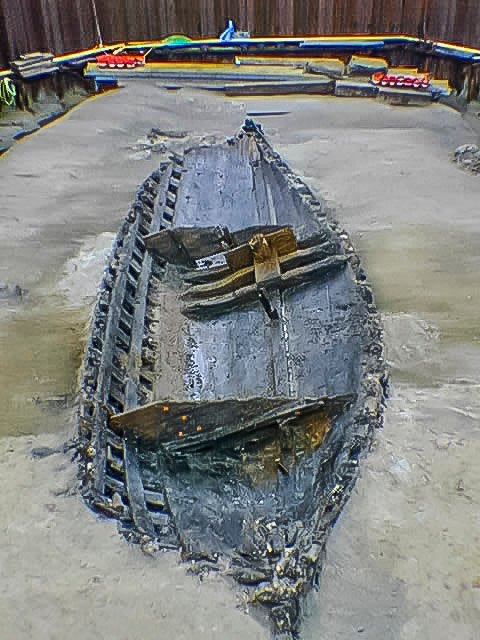
Running between the barge and the cofferdam was an aluminum catwalk. This bridge allowed the project team to go back and forth as needed. This was the only way to get across. So, I again grabbed my raincoat, my life jacket, a flashlight, and headed out of the building toward the catwalk. But, just as I reached the bridge, a large wave rolled up knocking me off my feet pushing the barge higher than any before. This stretched the catwalk beyond its capacity and it snapped, dropping into the water below. I just laid there and watched as it sank from view.
Now, there was no way to get to the cofferdam. I would have to remain on the barge. For a brief moment, I did consider jumping as the barge swayed toward the cofferdam but thought against it after considering what might happen if I missed. I then headed back to the office and immediately made another call. This time I was told to stay in the building and they would try to get help.
By now it was 3:00 am, and we had no idea who would be willing to come out in such a severe storm. While I waited, I wanted to check the aft mooring once again. I didn't want it to come lose and not have any idea until it was too late. It was the only thing keeping the barge from drifting off into stormy waters. As I walked aft, I could feel more play in the way the barged swayed in the water. I turned and looked forward seeing if the forward timbers were still floating between the barge and cofferdam or if the barge was now slamming into rot iron rods themselves. I could not see from where I stood so without checking the aft mooring, I went forward to get a better look. As I passed the office building, I watched as the electrical line and communication line that ran from the office building to the cofferdam and into our generator shed, rip out of the office building and dropped into the water. I couldn't believe what I just witnessed. Then it hit me, I turned and ran back to the aft mooring as quickly as possible only to find it too floating in the waves. I was now entirely free of the cofferdam. When the last mooring gave way, the electrical line and communication lines didn't stand a chance and pulled away easily from the office building.
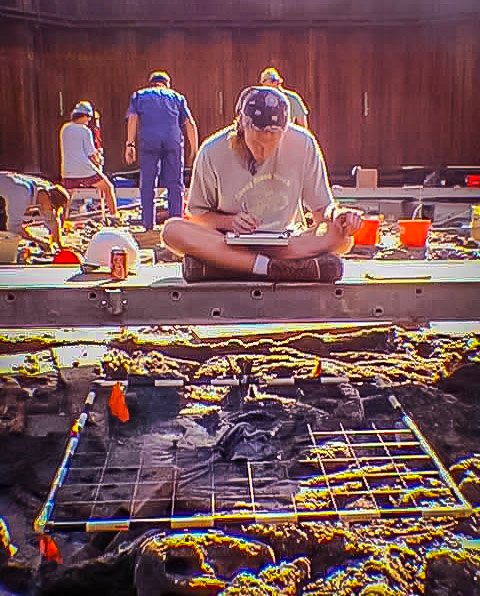
On the plus side, the barge was no longer slamming into the cofferdam and in fact, I was moving further and further away as I drifted away. Since the barge was a flat bottom boat, it provided little freeboard and the large waves crested over easily crashing over the bow and into the frail office building resulting in echoing sounds that reverberated over and over.
Now, the only communication I had was my cell phone, but I didn't imagine I would be able to get a signal. I rang the lab and miraculously someone picked up. The conversation was very garbled, but I was able to describe what was happening and told them I needed someone out here now.
By 4:00 am, I still had not heard from anyone, so I tried to call back. Unfortunately, I was never able to connect to the shore team again. Now, I just had to hope that help was on its way.
At about 5:30 am, I heard a boat's horn and I made my way outside to see a tugboat holding off my bow. One of their crew made several attempts to lasso the barge, but they were unsuccessful. But they were able to throw over a radio. After a few more attempts to attach the barge to the tugboat, the crew called over the radio and told me to hold tight. They would stay with me until the storm passed but it was too dangerous to bring the tug in closer.
By daybreak, the rains had stopped and the winds had died down enough for the tugboat to get a hold of the barge. After reinforcing the connection between the barge and tugboat, they began the trip back to port with the barge in tow. Finally, I was able to relax. I was exhausted so I went back to the office climbed into bed and went fast asleep.
The trip to the port took a couple of hours because the waves were still high enough that progress was slow, but by the time we arrived, I was more than ready to be on dry land.
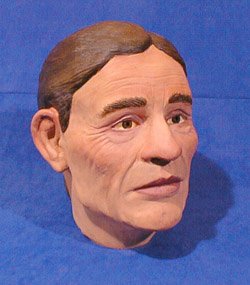
All content and photos are original
Enjoying my content? Please help support my efforts by resteeming.
Thanks So Much - Liquidtravel